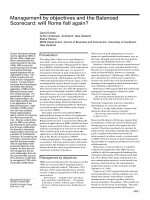Chap 8 developing marketing objectives and goals
Bạn đang xem bản rút gọn của tài liệu. Xem và tải ngay bản đầy đủ của tài liệu tại đây (217.18 KB, 16 trang )
Chapter 8
Developing Marketing Objectives and Goals
A. Intoduction
1. Defining Objectives and Goals: Chapter Organization (TM 8-1)
2. Problems with Defining Objectives (TM 8-2)
B. Corporate Strategic Direction
1. Meansing of Corporate Strategic Direction (TM 8-3)
2. Usefulness of Corporate Strategic Direction (TM 8-4)
3. Corporate Strategic Direction: An Example (TM 8-5)
4. Changing an Established Direction (TM 8-6)
C. SBU Mission
1. Defining Business Mission – Traditional Viewpoint (TM 8-7)
2. Defining Business Mission – A New Approach (TM 8-8)
3. Defining Business Mission – Narrow Scope (TM 8-9)
4. Defining Business Mission – Broader Scope (TM 8-10)
D. SBU Objectives and Goals
1. Defining Objectives (TM 8-11)
2. Illustration of an SBU’s Objectives (TM 8-12)
E. Product/Market Objectives
1. Bases of Product/Market Objectives (TM 8-13)
2. Sources for Generating Objectives (TM 8-14)
3. Validity Test for Objectives (TM 8-15)
255
256 CHAPTER 8: Developing Market Objectives and Goals
8-1
DEFINING OBJECTIVES AND GOALS:
CHAPTER ORGANIZATION
• Corporate strategic direction
• SBU mission
• SBU objectives and goals
• Product/market objectives
CHAPTER 8: Developing Market Objectives and Goals 257
8-2
PROBLEMS WITH DEFINING OBJECTIVES
• Lack of credibility, motivation, and/or
practicality.
• Poor information inputs.
• Defining objectives without considering
different options.
• Lack of consensus regarding corporate
values.
• Disappointing committee effort to define
objectives.
• Sterility (lack of uniqueness and competitive
advantage).
258 CHAPTER 8: Developing Market Objectives and Goals
8-3
MEANING OF CORPORATE
STRATEGIC DIRECTION
Broad statements that represent a company’s
position on various matters and serve as an
input in defining objectives and formulating
strategy at lower echelons in the organization.
CHAPTER 8: Developing Market Objectives and Goals 259
8-4
USEFULNESS OF CORPORATE
STRATEGIC DIRECTION
• Identifies what “fits” and what needs the
company is well suited to meet.
• Analyzes potential synergies.
• Undertakes risks that simply cannot be
justified on a project basis. For example,
willingness to pay for what might appear, on
a purely financial basis, to be a premium for
acquisition.
• Provides the ability to act fast. The presence
of strategic direction not only helps
companies adequately and quickly scan
opportunities in the environment, but helps
companies capitalize on them without
waiting.
• Focuses the search for opportunities and
options more clearly.
260 CHAPTER 8: Developing Market Objectives and Goals
8-5
CORPORATE STRATEGIC DIRECTION:
AN EXAMPLE
Hewlett-Packard Corporation
Profit — Achieve sufficient profit.
Customers — Provide products of greatest
value.
Field of interest — Enter new fields
judiciously.
Growth — Should be related to satisfaction of
real customer needs.
People — Help our people share in company’s
success.
Management — Foster initiative and creativity.
Citizenship — Honor our obligations to society
CHAPTER 8: Developing Market Objectives and Goals 261
8-6
CHANGING AN ESTABLISHED DIRECTION
• Need for change
• Awareness
• Broad support
• Pockets of commitment
• Clear focus
• Definite commitment
• New strategic direction
262 CHAPTER 8: Developing Market Objectives and Goals
8-7
DEFINING BUSINESS MISSION—
TRADITIONAL VIEWPOINT
Traditionally, the mission of a business
corporation was framed around its product line
and expressed in mottoes such as “our
business is textiles,” “we manufacture
cameras,” and so on.
CHAPTER 8: Developing Market Objectives and Goals 263
8-8
DEFINING BUSINESS MISSION—
A NEW APPROACH
Business is defined in terms of three measures:
• Scope (breadth of a business)
• Differentiation of the business unit offerings,
one from another, across segments
• Differentiation of the business unit offerings
from those of competitors
The above three measures are viewed in four
dimensions:
• Customer group served
• Customer functions served
• Technologies utilized
• Level of production/distribution
264 CHAPTER 8: Developing Market Objectives and Goals
8-9
DEFINING BUSINESS MISSION—
NARROW SCOPE
(Thermometer)
CHAPTER 8: Developing Market Objectives and Goals 265
8-10
DEFINING BUSINESS MISSION—
BROADER SCOPE
(Thermometer)
266 CHAPTER 8: Developing Market Objectives and Goals
8-11
DEFINING OBJECTIVES
• Activities (manufacturing a specific product,
selling in a particular market)
• Financial indicators (targeted ROI)
• Desired positions (market share, quality
leadership)
CHAPTER 8: Developing Market Objectives and Goals 267
8-12
ILLUSTRATION OF AN SBU'S OBJECTIVES
I. SBU
Cooking Appliances
II. Mission
To market to individual homes cooking appliances
that perform such functions as baking, broiling, and
roasting, using electric fuel technology.
III. Objectives (general statements in the following
areas):
A.
B.
C.
Measurement
1. Profitability
2. Cash flow
Growth/Survival
1. Market standing
2. Productivity
3. Innovation
Constraint
1. Capitalize on our research in certain
technologies
2. Avoid style businesses with seasonal
obsolescence
3. Avoid antitrust problems
4. Assume responsibility to public
IV. Goals
Specific targets and time frame for achievement of
each objective listed above.
268 CHAPTER 8: Developing Market Objectives and Goals
8-13
BASES OF PRODUCT/MARKET OBJECTIVES
• Profitability
• Market share
• Growth
• Other
— Technological leadership
— Social contribution
— Strengthening of national security
— International economic development
CHAPTER 8: Developing Market Objectives and Goals 269
8-14
SOURCES FOR GENERATING OBJECTIVES
• Focus on material resources (e.g., oil,
minerals, forest).
• Concern with fabricated objects (e.g., paper,
nylon).
• Major interest in events and activities,
handling emergencies (Emery Air Freight).
• Emphasis on the kind of person whose needs
are to be met: “babies are our business”
(Gerber).
• Catering to specific parts of the body, i.e.,
eyes (Maybelline), teeth (Dr. West), feet
(Florsheim), skin (Noxzema), hair (Clairol),
beard (Gillette), and legs (Hanes).
• Examination of wants and needs and seeking
to adapt to them, i.e., generic use to be
satisfied (nutrition, comfort, energy, selfexpression, development, conformity, etc.)
270 CHAPTER 8: Developing Market Objectives and Goals
8-15
VALIDITY TEST FOR OBJECTIVES
• Is it, generally speaking, a guide to action?
• Is it explicit enough to suggest certain types
of action?
• Is it suggestive of tools to measure and
control effectiveness?
• Is it ambitious enough to be challenging?
• Does it suggest cognizance of external and
internal constraints?
• Can it be related to both the broader and the
more specific objectives at higher and lower
levels in the organization?









